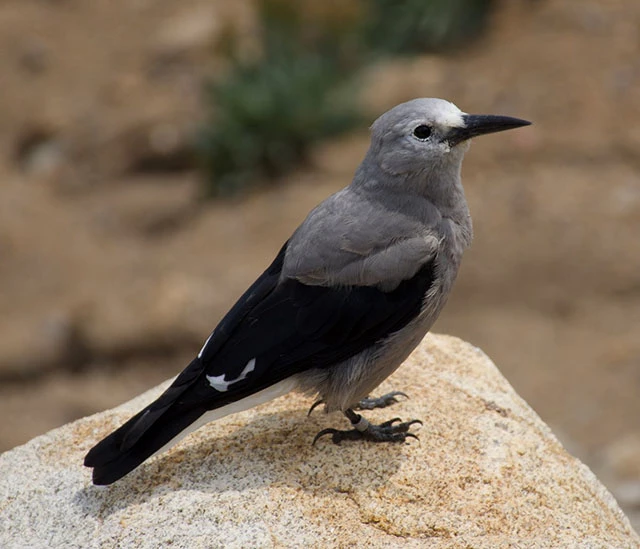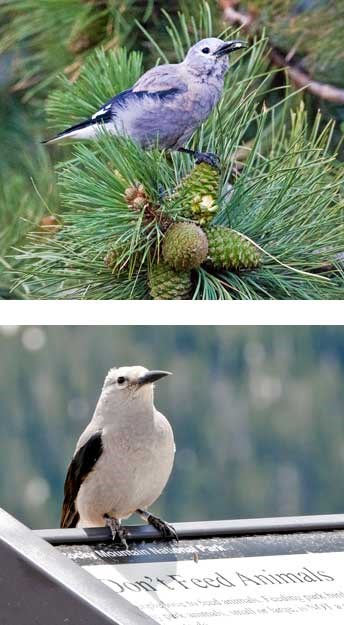
NPS Photo / Jim Ecklund 
Bottom: These birds also ask for handouts. Please do not feed them. NPS Nucifraga Columbiana(Length: 10.6-11.8 in (27-30 cm), Weight: 3.7-5.7 oz (106-161 g) General DescriptionClark's Nutcrackers are medium-sized birds with long, sharp bills. The Clark's Nutcracker is similar in size to a gray jay but more bulky in build and flight. Its body is mainly gray and has black wings with a few outer feathers that are white, and black down the center of its tail. On the upper side of the tail is black down the center and the undersides of the tail are white. HabitatClark's Nutcrackers live in open coniferous forests in the western United States and southwestern Canada, at anywhere from 3,000 to 12,000 feet. Starting in the summer, they become more copious in higher elevations. They are often spotted in stands of shrubby whitebark or pine with a nearby water source. In the fall, nutcrackers move down to lower elevations into forests that have the most available seeds. BehaviorClark's Nutcrackers have excellent spatial memory, which enables them to cache up to 33,000 seeds in the fall, and then locate a large percentage of those during the winter. Caches are generally buried in the soil on exposed slopes and can often find their caches up to nine months later. Not being 100 percent efficient at finding their caches functions as seed dispersal. When preparing to store seeds, this bird can store as many as 90 seeds in a pouch behind its tongue. This large seed cache allows the Clark's nutcracker to live in high elevations year round. They are bold around humans, often coming to populated hiking and camping areas to scavenge or beg for food. In late spring, family groups with juveniles join together into loose flocks. The nutcrackers are almost always in groups, except while caching seeds. Clark's Nutcrackers are often seen foraging with other birds and mammals along with their own species. When there are predators around (Red-tailed Hawks, Cooper's Hawks, Swainson's Hawks, Golden Eagles, and Great Horned Owls) the Clark's nutcrackers will mob and taunt in a playful manner. DietClark's Nutcrackers are omnivores, although the vast majority of their diet is pine seeds. They also eat other seeds, nuts, berries, insects, eggs and nestlings of other birds, and carrion. The young mostly eat seeds. All year round, the Clark's Nutcracker diet is pine seeds, either fresh or stored. It digs a trench in the soil with its bill and puts a cluster of seeds inside before covering them up again, or it pushes individual seeds into gravelly soil, pumice, or crevices in wood. NestingClark's nutcrackers are monogamous and form long-term pair bonds. Pairs stay together on their territories year round. They begin nesting in January, relying on the food they have cached to raise their young. Nests are in forks of the outer branches of conifers such as pines, larches, junipers, spruces, and firs near seed stores from the previous fall. They are built on the leeward side of trees for shelter from the wind, and they are often poorly concealed. It's not known how males or females contribute toward choosing nest sites. EggsTheir eggs are pale green with brown markings. Both members of the pair incubate the two to five eggs for 16-18 days, and then brood the young for their first 10-11 days. Both parents help feed the young, which leave the nest at about 18-20 days. The young remain with the parents until they are three and a half to four months old. Juvenile independence usually corresponds to availability of the year's seed crop, and they quickly start building their own caches for the following winter. MigrationShort distance migration is common (usually just a change in elevation), and irruptions can occur in years when food is less abundant. After the young fledge in late spring, most Clark's nutcrackers move upslope to subalpine zones, and then move back down in the fall. |
Last updated: May 20, 2018
